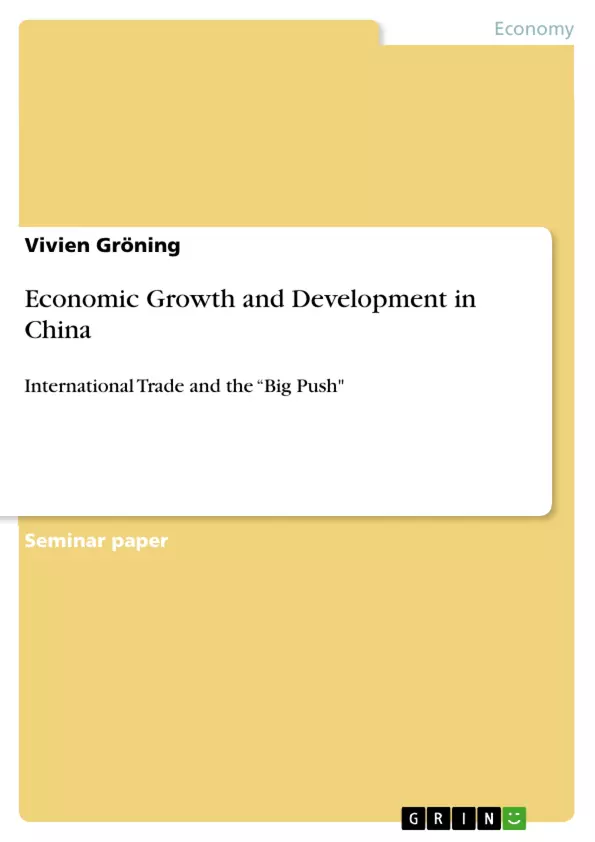If the need for a „Big Push“ survives in an economy that is open to international trade
and capital movements, or if openness to trade and capital movements is sufficient to
overcome all poverty traps, these questions have daunted development economics
since its inception (Jaime et al. 1997).
In the last two hundred years, every country with high development and productivity
rates has industrialised. While in the eighteens century Britain, and in the twenties
century Korea and Japan grew rich, other countries remained poor. One of the
discussed causes for this underdevelopment might be the small domestic market.
While the idea started with Rosenstein-Rodan (1943)1, who thought the solution would
be aid and investment programs, since the 1960s advocates tend to the Idea that
openness of the economy resolve the problem of a small domestic market. The theory
is that openness would induce an export-led „Big Push“ in terms of simultaneous
growth over different sectors (Murphy et al.1989, p.1003).
In the current discussion the „Big Push“ induced by aid has its comeback in the
Millennium Development Goals from the UN (Easterly 2005, p.3). The focus of this
paper is on the East Asian countries, where the export-promotion-policy had had an
important role. But Trindade (2005, p.41) was the first author who interpreted the
coordination-problem as solvable with solely export-promotion, because of the naturally
coordination effect of exports (Asche, 2005, p.24 gloss 28). So the question is not if
exports are good for an economy, but if exports can induce a „Big Push“ and thus
making aid superfluously.
Inhaltsverzeichnis (Table of Contents)
- Introduction
- The "Big Push" and International Trade
- The "Big Push"
- The "Big Push" and International Trade
- Evidence from East-Asia
- Conclusion
Zielsetzung und Themenschwerpunkte (Objectives and Key Themes)
This term paper aims to explore the relationship between international trade and the "Big Push" model of development, particularly focusing on whether an open economy can overcome development traps and induce simultaneous growth across sectors. The paper examines the theoretical framework of the "Big Push" and analyzes the potential role of international trade in facilitating this growth, drawing upon the work of Trindade (2005). It concludes by examining empirical evidence from East Asia to assess the applicability of the model in real-world settings.
- The "Big Push" model of development and its underlying assumptions
- The role of international trade in overcoming coordination failures and stimulating growth
- The potential for export-led growth to induce a "Big Push"
- Empirical evidence from East Asian economies
- The implications of the model for development policy and aid
Zusammenfassung der Kapitel (Chapter Summaries)
- Introduction: This chapter sets the stage for the term paper, outlining the historical context of the "Big Push" theory and the debate surrounding its relevance in an open economy. It highlights the potential for both international trade and aid to induce economic growth, but questions whether these factors can overcome development traps and trigger a "Big Push" effect.
- The "Big Push" and International Trade: This chapter delves into the theoretical framework of the "Big Push" model, exploring its core assumptions, including the concept of multiple equilibria, coordination failures, and the importance of a large enough market. It examines how the "Big Push" might be facilitated through international trade, particularly through the lens of Trindade's model (2005), which emphasizes the role of export-led growth. The chapter also analyzes potential limitations and challenges related to free trade and trade restrictions within the context of the "Big Push" model.
- Evidence from East-Asia: This chapter explores the empirical evidence of the "Big Push" model in East Asia, specifically analyzing the role of export-promotion policies in driving economic growth in the region. It examines whether the observed growth can be attributed to a "Big Push" effect or if other factors, such as technological advancements or investments in infrastructure, have played a more prominent role.
Schlüsselwörter (Keywords)
The main keywords and concepts explored in this term paper include: "Big Push", international trade, development trap, coordination failure, export-led growth, East Asian economies, multiple equilibria, market size, and economic growth. The paper examines the relationship between these concepts and their implications for development policy and aid, particularly within the context of overcoming development traps and achieving sustainable economic growth.
- Arbeit zitieren
- Vivien Gröning (Autor:in), 2006, Economic Growth and Development in China, München, GRIN Verlag, https://www.grin.com/document/142142



